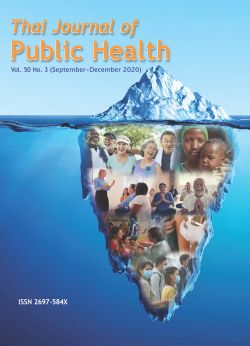Using Crotalaria bracteata Roxb. ex DC. as a Remedy for Herpes Zoster and Herpes Simplex: A Local Wisdom Case Study
Keywords:
Crotalaria bracteata Roxb.ex DC., herpes zoster, herpes simplexAbstract
Herpes simplex and herpes zoster are common. There are reports of resistance to antiviral drugs resulting in ineffective treatment. The purpose of this research was to study the effectiveness of Crotalaria bracteata Roxb.ex DC. for reducing the symptoms of herpes zoster and herpes simplex. The study involved 82 patients who were treated at Lomsak Hospital, Phetchabun province, Thailand, from 1 September 2018 to 31 August 2019. Data were collected by using interview forms and are presented as frequency, percentage, mean and standard deviation. Patients with trigeminal zoster or complications of herpes zoster (severe disseminated zoster i.e. more than 20 lesions outside the primary affected dermatome, meningoencephalopathic or ophthalmic involvement) were excluded. Immunocompromised patients (patients with concurrent malignancy receiving chemotherapy, patients receiving chronic steroid therapy, patients known to be human immunodeficiency virus seropositive) were also excluded. The treatment formula consisted of the leaves of Crotalaria bracteata Roxb. ex DC. mixed with clean water in a ratio of 2:3, blended thoroughly and packed into a 5-gram cream box. All patients were willing to apply the herbal remedy on to skin lesions twice a day, in the morning and evening. Patients were evaluated for the time to lesion crusting, the time to lesion healing and satisfaction levels after receiving treatment for 2 weeks. Lesion crusting was defined as the stage when all the papules and vesicles in the primary affected dermatomal region had resolved and full crusting had appeared. Lesion healing was defined as the stage when all crusts were lost. Satisfaction levels were evaluated by using a 5-point satisfaction scale rating from ‘least satisfied’ to ‘mostly satisfied’. The subjects were 52 female patients (63.4%). There were 20 herpes zoster patients (24.4%) and 62 herpes simplex patients (75.6%). Most of them were between 41-60 years old (46.3%). The youngest patient was 15 years old. The oldest patient was 80 years old. Just over one third of patients had primary school level education (34.1%) and were agricultural workers (34.1 %). In the majority of herpes zoster patients, skin lesions were located on the neck and body (70%), while herpes simplex patients mostly had lesions on the lips (64.5%). Lesion size in the majority of herpes zoster patients was 5.1 – 8.0 cm, while among herpes simplex patients it was less than 2.0 cm. The mean duration of lesion crusting in herpes zoster patients treated with Crotalaria bracteata Roxb.ex DC. was 3.7 days. For patients with herpes simplex, the mean duration of lesion crusting was 3.0 days. The mean duration of lesion healing in patients with herpes zoster was 6.5 days and 5.7 days in patients with herpes simplex. The majority of patients' satisfaction was at the highest level ‘mostly satisfied’ (62.2%). The majority of herpes zoster patients were satisfied with most ‘mostly satisfied’ (65.0%), as were herpes simplex patients (61.3%). This is the first research study to use Crotalaria bracteata Roxb.ex DC. for the treatment of herpes zoster and herpes simplex. The findings suggest that there may be an alternative way of using herbs from the community to treat herpes zoster and herpes simplex, as well as promote it as a household herbal remedy by mixing it with water and immediately applying it when herpes zoster or herpes simplex lesions appear.
References
2. Jon B. Suzich, Anna R. Cliffe. Strength in diversity: Understanding the pathways to herpes simplex virus reactivation. Virology 2018;522: 81-91
3. Linnemann CC Jr., Biron KK, Hoppenjans WG, Solinger AM. Emergence of acyclovir-resistant varicella zoster virus in an AIDS patient on prolonged acyclovir therapy. AIDS 1990;4:577-9.
4. Scieux C, Bianchi A. Resistance of herpes simplex viruses to antiviral drugs. Pathologie-biologie. Feb 1 1993;41(2):172-177
5. Leeyaphan C, Litrueangdech R, Maneeprasopchoje P, Boonchai W, Jiamton S . Herpes Zoster, Shingles (internet) Bangkok: Faculty of Medicine Siriraj Hospital, Mahidol University;2017 [cited 22 june 2018] Available from : https://www.si.mahidol.ac.th/siriraj_online/thai_version/Health_detail.asp?id=1085
6. Leeyaphan C, Boonchai W , Jiamton S. Herpes simplex (internet) Bangkok: Faculty of Medicine Siriraj Hospital, Mahidol University;2014 [cited 22 june 2018] Available from : https://www.si.mahidol.ac.th/th/healthdetail.asp?aid=35
7. Corey L, Benedetti J, Critchlow C, et al. Treatment of primary first-episode genital herpes simplex virus infections with acyclovir : results of topical ,intravenous ,and oral therapy. J Antimicrob Chemother. 1983;12(suppl B):79-88
8. Lanna Herbs. (Department of Pharmaceutical Botany, Faculty of Pharmaceutical Sciences, Mahidol University). Crotalaria bracteata Roxb. ex DC .Bangkok: Amarin Printing and Publishing ;1996. p. 81.
9. Srisa-ard B . Preliminary Research. Bangkok: Suwiriyasan ;2010. p. 120-121.
10. Karl R. Beutner, David J. Friedman, Christine Forszpaniak, Paul L. Andersen, Martin J. Wood. Valaciclovir compared with acyclovir for improved therapy for herpes zoster in immunocompetent adults. Antimicrobial agents and chemotherapy, July 1995:1546–1553
11. R.N. Werner, A.F. Nikkels, B. Marinovic, M. Sch€afer, M. Czarnecka-Operacz, A.M. Agius et al. European consensus-based (S2k) guideline on the management of herpes zoster – guided by the European Dermatology Forum (EDF) in cooperation with the European Academy of Dermatology and Venereology (EADV), Part 2- treatment. JEADV 2017;31:20–29.
12. Sangkitporn S, Balachandra K, Bunjob M, Chaiwat S, Dechatiwongse Na-Ayudhaya T, Jayavasu C. Treatment of Herpes zoster with Clinacanthus nutans (Bi Phaya Yaw) extract. J Med Assoc Thai 1995;78(11):624-7.
13. Chaiwasu C, Phonchan K, Sangkitporn S, Bunchup M, Chawalitthamrong P. Treatment of Herpes genitalis with Clinacanthus nutans (Bi Phaya Yaw) extract.. Communicable Disease Journal 1992;18(3):152-61.
14. Ke Hu, Aijun Dong, Hongwei Liu, Huisheng Feng, Qishi Sun, Xinsheng Yao. Bioactivity of traditional Chinese herbal medicines against pyricularia oryzae. Pharmaceutical Biology 1999 ;37(3):225–230
Table 1 Demographic characteristics of sample
Downloads
Published
Issue
Section
License
Creative Commons License CC-BY-ND


